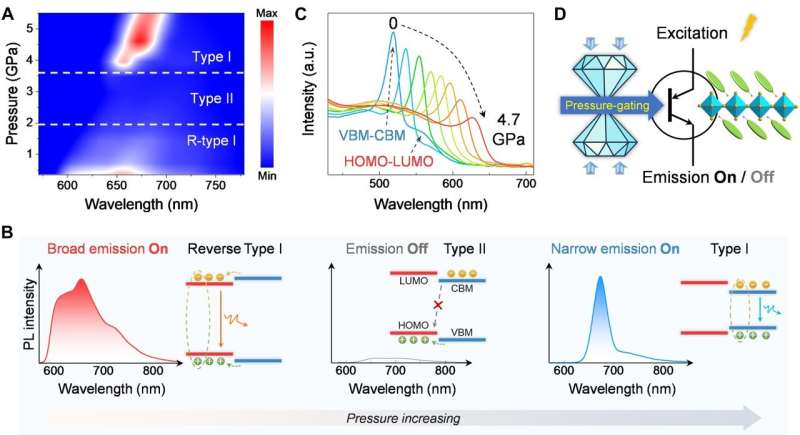Exploring pressure-gated band-edge states of 2D halide perovskites

In semiconductor heterostructures, reconfiguring the band-edge states and modulating their interplay with charge carriers in a continuous manner have been long-standing challenges.
Recently, an international research team led by Dr. Xujie Lü from the Center for High Pressure Science and Technology Advanced Research (HPSTAR) and Prof. Letian Dou from Purdue University chose the organic semiconductor-incorporated 2D halide perovskites as a model system and discovered that lattice compression induces band-alignment switching and charge redistribution, which realized controllable emission properties of these 2D hybrid semiconductor heterostructures.
The work has been published in the latest issue of Science Advances.
Two-dimensional (2D) semiconductor heterostructures are key building blocks for many electronic and optoelectronic devices. "Fundamental questions remain regarding the effects of the interfacial band states on the carrier dynamics and optoelectronic properties, which is limited by the scarcity of suitable material systems as well as the difficulty in continuously tuning the frontier electronic structures via conventional methods," said Dr. Lü. "To this end, we propose and realize the manipulation of band-edge states and charge distribution via mechanical—rather than chemical or thermal—regulation."
By continuously regulating the energy levels of organic and inorganic building blocks of organic semiconductor-incorporated 2D halide perovskites using external pressure, the researchers have demonstrated the possibility to fine-tune the band-edge states and the charge distribution of the 2D semiconductor heterostructures, which was previously unattainable.
"The band-alignment transition at the organic-inorganic interface is intrinsically not well-resolved at room temperature owing to the thermally-activated transfer and shuffling of band-edge carriers," explained Songhao Guo, a Ph.D. student at HPSTAR. "Thus, we introduce a two-level thermal equilibrium model to describe the charge distribution in the perovskite layers and organic ligands and the energy level difference can be accurately determined by fitting the in situ temperature-dependent PL spectra."
The researchers have also proposed a "pressure-gating" strategy that enables the control of multiple emission states within a single material.
For these 2D halide perovskites and vdWs semiconductors exhibiting different pressure responses of the building units, pressure processing not only provides an effective and clean manner to modulate their lattices, but also offers new opportunities for achieving configurable electronic properties with designable band-edge states and band alignments.
It is believed that the principles presented in this work could serve as a blueprint for the design, production, and fine-tuning of many other functional semiconductor heterostructures towards the realization of high performance by manipulating the band-edge states and the interfacial charge distribution.
More information: Songhao Guo et al, Reconfiguring band-edge states and charge distribution of organic semiconductor–incorporated 2D perovskites via pressure gating, Science Advances (2022). DOI: 10.1126/sciadv.add1984
Journal information: Science Advances
Provided by Center for High Pressure Science & Technology Advanced Research





















